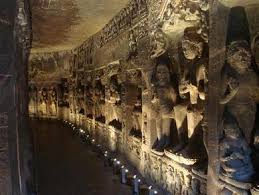old historic monument now converted into museum houses:-
An old historic monument now converted into museum houses a variety of ancient indian pottery, dresses, and remains of local palaces and antiques of daily use. a number of sculptures and reliefs from the local excavations university campus and is on the way to aurangabad caves.are also on display. it is located within dr. babasaheb ambedkar marathwada.
History:-
The building is situated in paharsinqpur, a suburb Aurangabad at a distance of about half K.M. To the north west of the famous Bibi-ka Maqbara.
This was -roe the residence of maharaja of cliched who helped Aurangzeb in the inquest of the Deccan. The building is in stone and lime and has a high plinth. It is sad in have obtained it's name soneri mahal from the paintings of gold which at one time decorated it.
paintings:-
paintings:-
It is a spacious building of lwo storegs, constructed in and typical Rajput style. The main gateway is in tact but compound wall has practically disappeared.
Rajput style construction:-
Rajput style construction:-
The soneri mahal was constructed by a bandaland chief who come with Aurangzeb into the Dakhan. The mahal is located in paharsingpura which is a suburb of Aurangbad. The structure is made of stone and lime. The mahal has a high pedestal but it is now in dilapidations.
stone and lime structure :-
stone and lime structure :-
The paintings in the mahal were once painted of gold and so the name soneri mahal.The soneri mahal finishes the mughal grandness with it's remnants of glory that rejects to fade. Indians are charged Rs 10 and foreigners Rs 100 as entrance fee and the timings are from 8am to 6pm.
The ellora Ajanta festival takes place in Aurangabad's 17th century architectural marvel,the soneri mahal haveli virtuoso indian musicians and dances perform classical and dances, instrumental pieces and songs,while hundreds of stalls in kola gram sell regional artisans work.
Best Time To Visit:-
1. Timings : 8:00am To 6:00pm
2. For Indians : Rs. 10/- per head
3. For Foreigners : Rs. 100/- per
head
Map Aurangabad to Soneri Mahal:-





















































